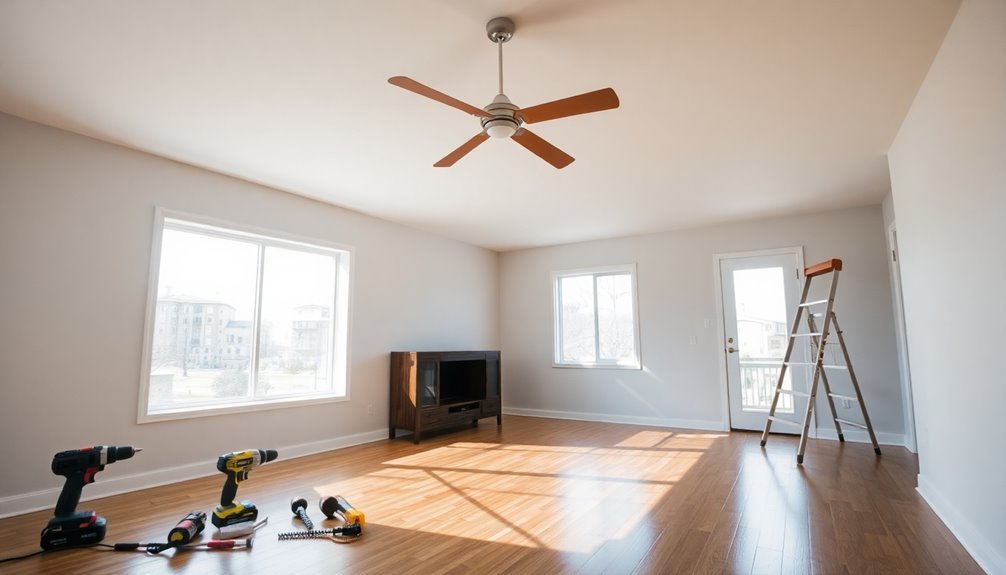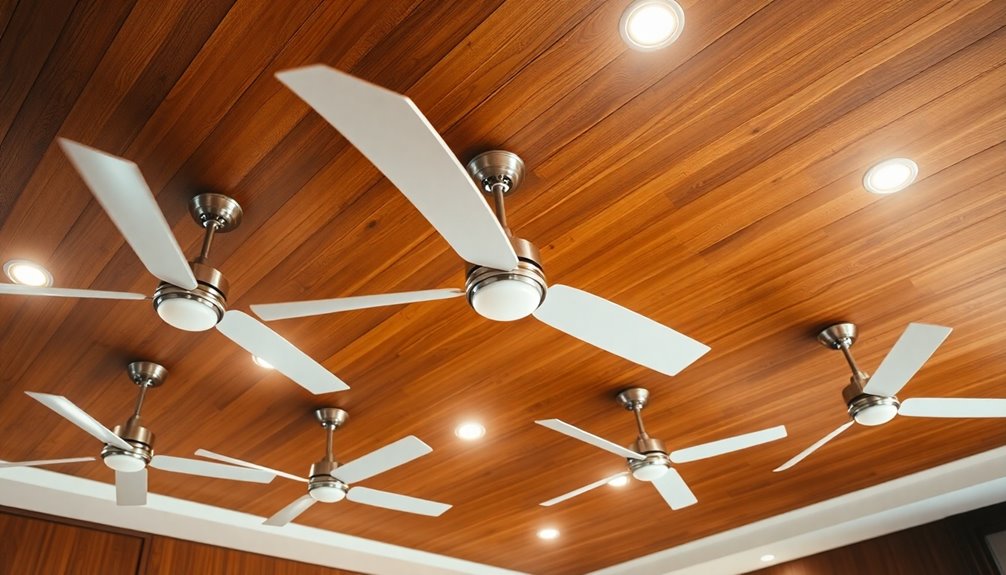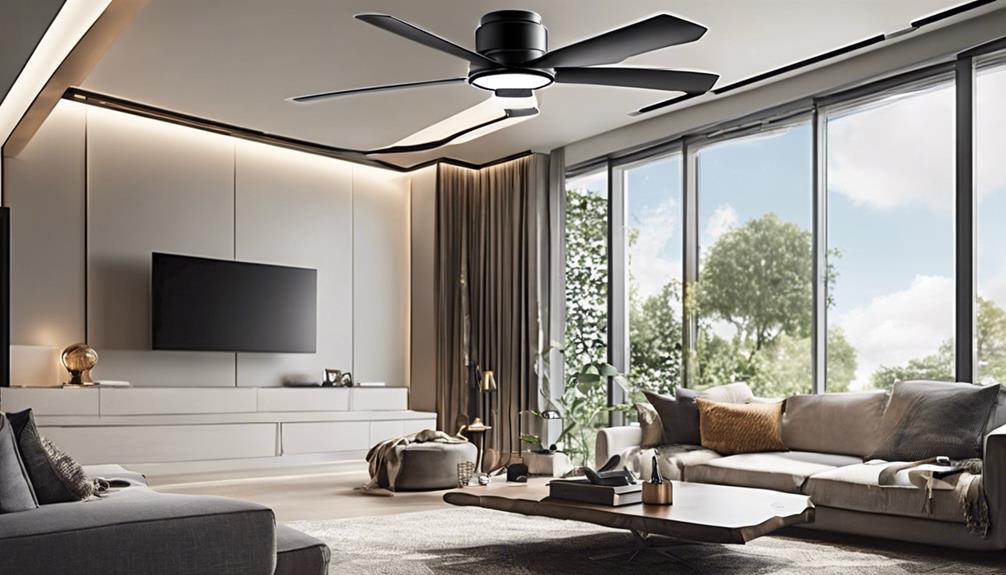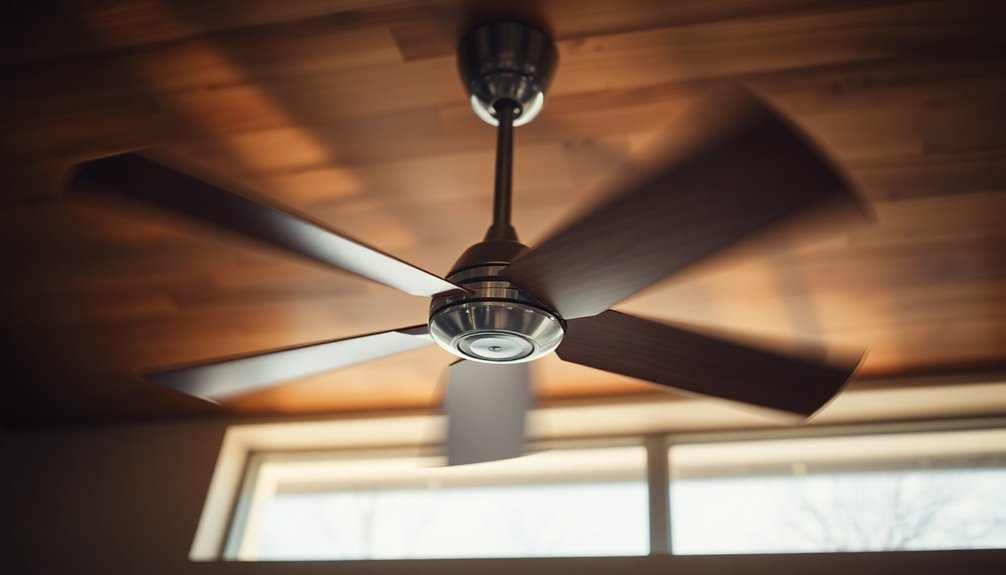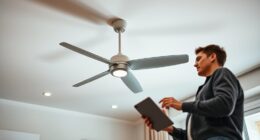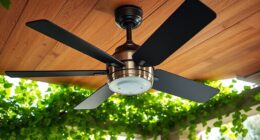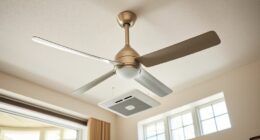Installing a ceiling fan usually costs between $144 and $353, with the average price around $248. If you're using existing wiring, basic installations can be on the lower end, while new wiring can push costs up to $2,000. Features like built-in lighting or remote controls can also add $100 to $600 to your total. You might contemplate a DIY installation if you're handy, which typically costs between $100 and $275. If you're unsure, hiring a professional is wise for safety and compliance. There's more to reflect on about types of fans and installation options you won't want to miss!
Key Takeaways
- Average installation costs for ceiling fans range from $144 to $353, with a typical price around $248.
- Basic installation using existing wiring typically costs between $100 and $300.
- New wiring installation can significantly increase costs, potentially up to $2,000.
- DIY installation can range from $100 to $275, while professional installation averages about $248.
- Additional features like built-in lighting or remote control can add $100 to $600 to total installation costs.
Ceiling Fan Installation Costs

When you're considering adding a ceiling fan to your home, it's important to understand the costs involved in installation. The average cost to install a ceiling fan ranges from $144 to $353, landing around $248 for professional installation.
If you already have existing wiring, basic ceiling fan installation can be relatively affordable, typically costing between $100 and $300. However, if new wiring is necessary, you could see costs skyrocket to as much as $2,000, especially for complex setups.
If your chosen fan comes with built-in lighting features, expect to add an extra $100 to $300 to your total installation costs. Additionally, if you want a remote control for convenience, that'll set you back another $150 to $300.
Remember that labor costs can vary considerably based on your location and the installer's rates. Always get multiple quotes to make sure you're getting a fair deal.
Ultimately, knowing these ceiling fan installation costs upfront helps you budget effectively and avoid surprises down the road.
Types of Ceiling Fans

Ceiling fans come in various types, each designed to suit different spaces and needs. Understanding the types of ceiling fans available can help you choose the right fit for your home.
| Type of Ceiling Fan | Installation Costs |
|---|---|
| Standard Ceiling Fan | $50 – $300 |
| Low-Profile Fans | $50 – $300 |
| Hanging Propeller Fans | $150 – $550 |
| Directional Fans | $150 – $800 |
| Rotational Fans | $200 – $1,500 |
| Outdoor Ceiling Fans | $250 – $3,000 |
Standard ceiling fans often include a new fan/light, enhancing functionality. Low-profile fans are perfect for rooms with ceilings under 8 feet. If your ceilings are over 9 feet, consider hanging propeller fans for maximum airflow. Directional fans are great for adjustable airflow, while rotational fans provide dual motor options for more power. If you're looking for outdoor ceiling fans, verify they're wet-rated to withstand the elements. Many of these types can also be Energy Star-rated, helping you save on energy costs while keeping your space cool. Additionally, increased fan efficiency leads to lower energy bills and a more comfortable living environment.
Wiring Considerations

Proper wiring is essential for a successful ceiling fan installation. First, you'll want to assess your existing wiring. If it's compatible with your new ceiling fan, you could save considerably on installation costs, typically ranging from $100 to $300.
However, if you need new wiring, especially in areas lacking suitable connections, costs could soar up to $2,000.
Make sure your wiring can handle the fan's requirements to guarantee safety and efficiency. The ceiling box must be fan-rated to support the fan's weight and movement, preventing potential hazards.
If you plan to add built-in lighting, factor in additional wiring costs, usually between $100 and $300.
Complex installations, like those that require directional or rotational fans, might involve extra electrical work, further affecting your budget.
Always prioritize safety by confirming that the wiring setup meets all necessary standards. By understanding these wiring considerations, you can make informed decisions that align with your budget and guarantee a safe, functional ceiling fan installation.
DIY vs. Professional Installation

Installing a ceiling fan can be a rewarding DIY project, but it comes with its challenges. If you have a good understanding of electrical systems, you could save on installation labor costs, with DIY expenses ranging from $100 to $275, including the fan and necessary tools. Additionally, having the right smart home device integration can enhance the functionality of your ceiling fan, allowing for remote control and energy monitoring.
However, if you're unfamiliar with wiring, it might be wise to take into account professional installation, which typically costs between $144 and $353, averaging about $248.
Hiring licensed electricians guarantees that your installation adheres to local electrical codes, providing peace of mind. This is especially important if your project involves new wiring, as that could cost up to $2,000.
Basic installations can take professionals about 1-2 hours, while DIY installations may take longer, particularly if you encounter unexpected issues.
While going the DIY route can save money, mistakes can lead to safety hazards and extra expenses for ceiling fan replacement or repairs. Additionally, understanding power requirements for gas lines is crucial for ensuring that your ceiling fan operates safely and efficiently.
In the end, weigh the installation time and potential risks against the costs to determine what's best for your situation. If safety and peace of mind are priorities, professional installation might be the way to go.
Cost-Saving Tips

Looking to save some cash on your ceiling fan installation? Here are some cost-saving tips to help you reduce costs while enjoying a cool breeze:
- Use Existing Wiring: Installing fans near existing wiring can greatly lower installation expenses. New wiring can cost up to $2,000, so position your fans strategically. Additionally, using energy-efficient appliances can further reduce your overall energy costs.
- Shop During Off-Peak Seasons: Timing can affect your budget. Purchasing ceiling fans during off-peak seasons may lead to better prices and discounts, helping you save on materials and labor.
- Consider ENERGY STAR-rated Fans: These fans not only enhance energy efficiency but also lower your utility bills over time, providing long-term savings.
If you're handy, think about a DIY installation for simple setups. Hiring a handyperson can save you $50 to $200 compared to a licensed electrician for basic tasks.
However, for complex installations, it's best to stick with a licensed electrician to guarantee safety and compliance. Additionally, opting for eco-friendly toilets can complement your cost-saving efforts by reducing overall household water consumption.
Frequently Asked Questions
How Much Does Labor Cost to Install a Ceiling Fan?
When considering labor costs for installing a ceiling fan, you'll find they typically range from $50 to $200 per hour, depending on your location and the complexity of the job.
An electrician usually charges around $150 for the first hour, with subsequent hours costing between $50 and $130.
A basic installation might take 1-2 hours, while more complex setups could stretch to 3-4 hours, impacting your total labor expenses.
How Much Does Home Depot Charge to Install a Fan?
When you're considering getting a ceiling fan installed, Home Depot typically charges between $150 and $300, depending on the job's complexity and local rates.
If your installation needs new wiring or electrical work, costs can rise considerably.
Expect the installation to take about 1 to 2 hours for a standard setup.
Plus, you might have optional features that could add $100 to $300 to your total.
Always check for warranties on workmanship, too!
How Long Does It Take an Electrician to Install a Ceiling Fan?
When you hire an electrician to install a ceiling fan, the process usually takes about 1 to 2 hours for a standard installation.
If your project needs new wiring or has tricky conditions, it might take 3 to 4 hours.
Keep in mind that the electrician will assess your existing wiring and ceiling setup, which can affect the time.
Scheduling enough time guarantees they can complete the job safely and thoroughly.
Can the Average Person Install a Ceiling Fan?
Imagine trying to bake a cake without knowing how to mix ingredients—it mightn't turn out well.
Installing a ceiling fan's a bit like that. You can definitely do it, but it helps to know some basics about wiring and safety.
If you're comfortable with tools and instructions, you can tackle it. Just make sure your ceiling box is rated for fans.
If you're unsure, don't hesitate to call in a pro!
Conclusion
In the end, installing a ceiling fan can be as simple as a summer breeze or as complex as a Shakespearean drama, depending on your approach. Whether you choose to tackle it yourself or hire a pro, understanding the costs and options is key. Just like Icarus, you don't want to soar too close to the sun with your budget. By weighing your choices wisely, you can enjoy a cool, comfortable space without breaking the bank.
